#end israeli destruction
Explore tagged Tumblr posts
Text

#motaz azaiza#motaz instagram stories#palestine#gaza#endisraelsgenocide#end israeli destruction#i stand with palestine 🇵🇸#free gaza#free palestine 🇵🇸#gaza strip#free palestine#gazaunderattack#palestine resources#israeli terrorism#israel is a terrorist state#israel is committing genocide
934 notes
·
View notes
Text
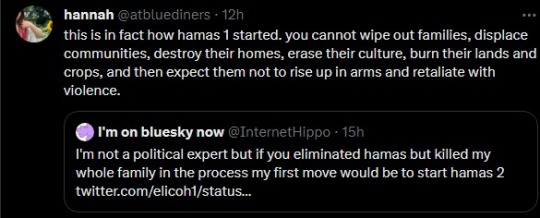
also remember that no form of resistance is ever acceptable to the colonizer. and that includes non-violent resistance (the great march of return) + non-violence is only successful against a force that has a conscience. but if your opponent had a conscience, he would not be oppressing you in the first place.
#its a bit weird how people who have been oppressed for decades are held to this moral standard that not even their oppressor is held to tbh#also yeah agreed w the person here like if i was a part of such a group being oppressed i would not just sit and take it#there's only so much pain and loss you can take#israelis want to cause so much destruction that it debilitates the palestinians but it ends up fuelling their desire to fight back even mor#i was just reading up on how initially the people who made up hamas focused on social services#and only became interested in developing a militant wing after israel's brutal occupation of south lebanon#and the plo's retreat#even before oct 7#hamas fighting back was never acceptable to Israel#even if they were only using rockets made of scrap metal. no form of resistance can ever be acceptable to the occupier.#free palestine#palestine#gaza#israel#israeli war crimes#death to israel#long live palestine#glory to the martyrs#from the river to the sea palestine will be free#long live the resistance
846 notes
·
View notes
Text
🇵🇸 🚨
Extent of the Destruction In Gaza
📹 Displaced Palistinian youth visit Khan Yunis after six months of Israeli bombardment, carrying the flag of Palestine before planting it on the rubble and debris that are all that remains of their family home.
#source
@WorkerSolidarityNews
#gaza#gaza strip#gaza news#palestine#palestine news#palestinians#free palestine#free gaza#solidarity with palestine#israel#israeli occupation#israeli war crimes#israeli crimes#israeli terrorism#destruction in gaza#genocide#israeli occupation forces#middle east#israel palestine conflict#war#occupation#end the occupation#ceasefire now!#politics#news#geopolitics#world news#global news#international news#current events
40 notes
·
View notes
Text
Israel's Genocide of Palestinians in Gaza by STARVATION!!!

At the start of summer, Gaza's fields are usually bursting with ripening crops and fruits of all colours, scents and sizes.
But, nearly nine months into Israel’s war on Gaza, abundant harvests have given way to devastation and a dire humanitarian crisis.
A UN report says 96 percent of Gaza’s population is food insecure and one in five Palestinians, or about 495,000 people, is facing starvation.
Satellite images analysed by Al Jazeera's digital investigation team, Sanad show that more than half (60 percent) of Gaza's farmland, crucial for feeding the war-ravaged territory’s hungry population, has been damaged or destroyed by Israeli attacks.
Israel has killed at least 37,900 people and injured 87,000 others in bombings, by destroying healthcare that could have saved them, and by starvation.
North to south, nowhere and nobody has been spared.

North Gaza
In Beit Lahiya, once known for plump, juicy strawberries that locals fondly called "red gold", Israeli bulldozers and heavy machinery have systematically razed fields, reducing them to dirt.
Before the war, Gaza's strawberry industry employed thousands of people. Seeding and planting began in September, with harvesting from December through March.

A Palestinian farmer carries a box of strawberries on a farm in north Gaza [File: Getty Images]
Before and after satellite images show vehicle tracks over the once-fertile regions of Beit Lahiya.

Defying Israel’s ongoing attacks, farmers like Youssef Abu Rabieh figured out ways to grow food between bombed-out buildings - makeshift gardens of repurposed containers.

Palestinian farmer Youssef Abu Rabieh launched his agricultural initiative despite ongoing Israeli attacks in Beit Lahiya, on April 28, 2024 [Mahmoud Issa/Anadolu via Getty Images]
Gaza City
Thriving garden patches and back-yard fruit trees once dotted Gaza City, home to about a third (750,000) of Gaza’s 2.3 million population before the war.
South of Gaza City is Zeitoun, a neighbourhood named after the Arabic word for olive. Before and after satellite images show southern Zeitoun where nearly every last bit of greenery has been wiped out.

The olive tree is deeply beloved in Palestine, symbolic of Palestinian resilience against Israeli occupation.
During one short pause in fighting from November 22 to December 1, Palestinian farmers ran to harvest their olives and extract oil, because they do not know any other way to live, and because they needed the harvest.
Olive cultivation is crucial in the Palestinian economy and is used for everything from oil to table olives to soap.

Palestinian farmers work to press the olive crop for oil during the one-week pause in Gaza City, November 27, 2023 [Doaa Albaz/Anadolu via Getty Images]
Deir el-Balah
Its very name meaning "House of Dates", the central governorate of Deir el-Balah is one of Gaza’s largest agricultural producers, known for its oranges, olives and - of course - dates.
The date harvest typically begins in late September and continues through the end of October.

Palestinian farm workers collect dates in Deir el-Balah, Gaza, September 30, 2021 [AP Photo/Adel Hana]
The satellite images below show the widespread destruction of farms, roads and homes in eastern Maghazi in the centre of Deir el-Balah.

Khan Younis
Khan Younis in the south used to produce the bulk of Gaza’s citrus, including oranges and grapefruits.
With its fertile soil and long hours of Mediterranean sunshine, it has the ideal climate as well as lots of space, being Gaza’s largest governorate - about 30 percent of the Strip’s 365sq km (141 sq miles).

Farmers pick citrus fruits in Khan Younis on November 7, 2022 [Majdi Fathi/NurPhoto via Getty Images]

Rafah
Rafah is Gaza’s southernmost district, with a pre-war population of about 275,000 people.
Rafah is also the name of the crossing with Egypt which used to be a vital link between Gaza and the rest of the world before it was destroyed by Israel in May.
In the southeast of Rafah is the Karem Abu Salem (Kerem Shalom) crossing where goods grown or produced in Gaza were shipped out of the territory.
Before and after satellite imagery shows how Israeli forces have flattened vital fields in eastern Rafah


A Palestinian farmer picks tomatoes to be exported into Israel, on a farm in Deir el-Balah on March 11, 2015 [Ibraheem Abu Mustafa/Reuters]
Israel has imposed a land, air and sea blockade on Gaza since 2007 but the ingenious farmers of the enclave still managed to build a vibrant, mostly subsistence, agricultural sector before Israel's latest assault.
Faced with a lack of inputs because Israel controlled imports and exports, the farmers made it work anyway.
Like Mohammed Abu Ziyada, 30, who could not be more proud of the first crop of red corn he grew using seeds from China.
Abu Ziada, who farms in Beit Lahiya, decided to try red corn because it needs less water and fewer agricultural inputs than other corn varieties.

Abu Ziyada with his red corn [File: Mustafa Hassona/Anadolu via Getty Images]
In 2022, Gaza's farmers exported $44.6m worth of produce, according to the Palestinian Ministry of Agriculture [PDF], but Israeli restrictions limited sales to a few neighbouring countries.
The vast majority of this produce (79 percent) was sold to the occupied West Bank, generating about $35.4m, followed by $8.4m to Israel (19 percent), $661,975 to the Gulf Cooperation Council (GCC) and the remaining $138,868 to neighbouring Jordan.

Among Gaza’s exports in 2022 by trade value, one-third of them (32 percent) were strawberries, 28 percent tomatoes and 15 percent cucumbers.
Other exports include: eggplants (9 percent), sweet peppers (6 percent), zucchini (3 percent), chillies (2.5 percent), potatoes (1 percent) and sweet potatoes (0.5 percent).


Palestinian fishermen try to fish with rowboats and rods off the shore of Gaza City. Damaged and destroyed buildings are visible behind them on May 26, 2024 [Dawoud Abo Alkas/Anadolu via Getty Images]
Gaza’s 4,000 fishermen played a crucial role in Palestinian food security, supplying essential animal protein through the seafood with the catches they managed within the 12 nautical miles (22km) permitted by Israel.
In 2021, Gaza produced about 4,700 tonnes of fish according to the Palestinian Central Bureau of Statistics.
Since October 7, many fishermen have been unable to access the sea, while others risk their lives to bring food in, severely impacting Gaza's ability to feed itself.

Smoke rises after Israeli air strikes on fishing boats at Gaza Port on October 12, 2023 [Ashraf Amra/Anadolu]
The satellite images below show the extensive damage to Gaza’s main fishing port in Gaza City where almost all boats have been destroyed, along with significant damage to the road along the main pier.


Skeletons of buildings stand in Gaza, amid Israel's ongoing assault on the Palestinian enclave, June 25, 2024 [Amir Cohen/Reuters]
In February, the UN Food and Agriculture Organization (FAO) assessed the agricultural and livestock damage across Gaza.
They found significant damage to:
626 wells
307 home barns
235 chicken farms
203 sheep farms
119 animal shelters
In addition, they estimated that 27 percent - 339 out of 1,277 hectares (3,156 acres) - of Gaza’s greenhouses were damaged by Israel’s assault.


Palestinians cover their fishing boats with sand to protect them from phosphorus bombs dropped by Israel, December 17, 2023 [Mohammed Talatene/Picture Alliance via Getty Images]
Experts say military hardware and bombs have damaged Gaza's fertile soil for many years.
“There will be years of destruction because of the material used in the explosives and phosphorus bombs used there, this will affect the land and water in the long term,” agricultural consultant Saad Dagher told Al Jazeera.
youtube
#forced starvation#forced famine#ecocide#destruction#farms#free Palestine#free gaza#I stand with Palestine#Gaza#Palestine#Gazaunderattack#Palestinian Genocide#Gaza Genocide#end the occupation#Israel is an illegal occupier#Israel is committing genocide#Israel is committing war crimes#Israel is a terrorist state#Israel is a war criminal#Israel is an apartheid state#Israel is evil#Israeli war crimes#Israeli terrorism#IOF Terrorism#Israel kills babies#Israel kills children#Israel kills innocents#Israel is a murder state#Israeli Terrorists#Israeli war criminals
11 notes
·
View notes
Text
the venn diagram of people who glorify + romanticize the IRA and people who call Hamas “freedom fighters” is nearly a perfect circle
#i am Irish and Jewish#and it astounds me to no end#how literally everyone can find it in them to justify reckless violence#as long as its against people they’ve arbitrarily decided are evil#random Jews & Israelis are not Benjamin Netanyahu#just like#random Protestants & Brits are not the Prime Minister or the monarchy#and if we’re really being technical abt it#Israel are the Catholics of this analogy#the IRA is closer to the IDF but i digress#oh and after all that bloodshed and terror and death and destruction#still no United Ireland 🙃#and I am a capital R Republican#but we will never get there with indiscriminate violence
27 notes
·
View notes
Text
The UN should already expel the rogue state for far more than an UNRWA ban...
#palestine#palestinians#gaza#genocide#civilian deaths#war on children#attacks on unrwa#israeli terrorism#israeli atrocities#israeli apartheid#israeli illegal occupation#icj ruling#end the occupation#illegal annexation#un violations#human rights violations#idf terrorists#iof terrorism#iof war crimes#israeli occupation#war crimes#free palestine#free gaza#justice#icc arrest warrant#arrest netanyahu#rogue state#pariah state#collective psychosis#destruction of rules based order
3 notes
·
View notes
Text
npr's coverage of the ongoing war in palestine is the most jaw dropping and gut wrenching examples of liberal journalism i've ever had the opportunity to experience in real time
#giving coverage to the israeli protesters that wouldn't allow aid into gaza#the palestinians need to use their voice to stop hamas and realize what they've done and take accountability!! WHAT???#WHEN? HOW? WHERE? even if that were not the most batshit thing i've ever heard. how should they do this? you want them to all chant#from the rubble and destruction while holding hands with their dead family#who were killed by israeli air strikes#what do you want them to say? will the war end if they condemn hamas? will it bring their families back? their homes? their lives?#would you listen? have you been listening? they don't deserve food and water? healthcare?#this is the most barbaric shit i think i've ever seen and it being presented to me#by that fucking cool voiced woman who works at npr like it was something that you should take at face value#like it's not genuinely the most vile and despicable thing i've ever heard#their minds are so poisoned
4 notes
·
View notes
Text
youtube
#bible prophecy endtimes#end times#endtimes#jesus is coming#bibleprophecy#youtube#faith in jesus#follow jesus#time is running out#spread the word#pestilence#birth pangs#signs of the end times#wars and rumors of wars#jesus is returning#jesus is the way#rapture of the church#stand fast in the faith#world war three#war of gog and Magog#iran strikes israeli#Damascus Syria#psalm 83#peace and security#sudden destruction#time to repent#give glory to god#end of days#the four horsemen of the apocalypse#seven year tribulation
0 notes
Text
The economic indicators speak of nothing less than an economic catastrophe. Over 46,000 businesses have gone bankrupt, tourism has stopped, Israel’s credit rating was lowered, Israeli bonds are sold at the prices of almost “junk bonds” levels, and the foreign investments that have already dropped by 60% in the first quarter of 2023 (as a result of the policies of Israel’s far-right government before October 7) show no prospects of recovery. The majority of the money invested in Israeli investment funds was diverted to investments abroad because Israelis do not want their own pension funds and insurance funds or their own savings to be tied to the fate of the State of Israel. This has caused a surprising stability in the Israeli stock market because funds invested in foreign stocks and bonds generated profit in foreign currency, which was multiplied by the rise in the exchange rate between foreign currencies and the Israeli Shekel. But then Intel scuttled a $25 billion investment plan in Israel, the biggest BDS victory ever. These are all financial indicators. But the crisis strikes deeper at the means of production of the Israeli economy. Israel’s power grid, which has largely switched to natural gas, still depends on coal to supply demand. The biggest supplier of coal to Israel is Colombia, which announced that it would suspend coal shipments to Israel as long as the genocide was ongoing. After Colombia, the next two biggest suppliers are South Africa and Russia. Without reliable and continuous electricity, Israel will no longer be able to pretend to be a developed economy. Server farms do not work without 24-hour power, and no one knows how many blackouts the Israeli high-tech sector could potentially survive. International tech companies have already started closing their branches in Israel. Israel’s reputation as a “startup nation” depends on its tech sector, which in turn depends on highly educated employees. Israeli academics report that joint research with universities abroad has declined sharply thanks to the efforts of student encampments. Israeli newspapers are full of articles about the exodus of educated Israelis. Prof. Dan Ben David, a famous economist, argued that the Israeli economy is held together by 300,000 people (the senior staff in universities, tech companies, and hospitals). Once a significant portion of these people leaves, he says, “We won’t become a third world country, we just won’t be anymore.”
19 July 2024
6K notes
·
View notes
Text
GLOBAL STRIKE ON APRIL 15

"The terrorist Israeli occupation, after half a year, is still insisting on entering Rafah, which is the last city that still contains most of the population of the Gaza Strip.
80% of the Gaza Strip is destroyed and suffers from continuous military invasions, the movement of the Israeli army, besieging hospitals, commit massacres, destroy and blow up residential neighborhoods. And besieging the population and starving them.
The terrorist occupation is committing these crimes in front of the world, and is trying to have more time to destroy the hopes of the displaced to return and kill them with hunger and disease, and make the world get used to what is happening in Gaza and reduce media coverage and solidarity with Palestine, in addition to causing more destruction and strengthening the presence of the Israeli terrorists in Gaza in preparation for stealing the land.
Be smarter than them, and do not leave us to be killed and forgotten. *April 15 is a day of global strike*.. No schools, no movement, no work, no electronic payment, no gas stations. Make more noise and disturb the peace of terrorist politicians in America and IsraHell.
In the picture, me after half a year of documenting the genocide and surviving it daily without being sure of surviving the next day, and I will not stop until this genocide ends and I sit in the middle of my city feeling safe while I help my people rebuild Gaza."
Here's what to do:
Don't go to school or work (if you can)
Protest (if you can)
Do not shop anywhere
Do not use your credit card or use any money
Wear green, red, white and black clothes to show solidarity. Wear a badge, a keffiyeh, or anything that signifies your solidarity
Boost posts about Palestine, flood the media
Boycott!
#gaza#free gaza#gaza strip#israel is a terrorist state#genocide#jerusalem#gazaunderattack#palestine#israel#free palestine#rafah#tel aviv#free free palestine#current events#news on gaza#yemen#save rafah#rafah under attack#all eyes on rafah#free rafah#khan younis#colonialism#colonization#west bank#israeli occupation#al shifa hospital#egypt#lebanon#united nations#United nations
11K notes
·
View notes
Text
instagram

#endisraelsgenocide#end israeli destruction#israeli terrorism#palestine#gaza#environmentalism#environmetalists#i stand with palestine 🇵🇸#free gaza#free palestine 🇵🇸#gaza strip#free palestine#gazaunderattack#palestine resources#israel is a terrorist state#israel is committing genocide#Instagram
57 notes
·
View notes
Text
🇵🇸 🚨
DESTRUCTION ON AN UNIMAGINABLE SCALE IN FULL-SCALE HALOCAUST IN GAZA
📹 Scenes of destruction on an unimaginable scale in modern times as a full-scale Halocaust is inflicted on the Palestinian population of the Gaza Strip.
According to United Nations demining expert, Mungo Birch, the amount of rubble, debris and unexploded ordnance in the Gaza Strip now exceeds that of Ukraine following two years of war.
"To understand the magnitude of the matter, the battle front in Ukraine is 600 miles (about 1,000 kilometers) long, while Gaza is only 25 miles (about 40 kilometers) long, and it is all a battle front," Birch said in an announcement on Wednesday.
The UN demining expert went on to say that the problem is not limited to the extent of rubble piled up across Gaza, estimated at over 37 million tonnes of debris; the rubble also contains large numbers of unexploded ordnance and presents other additional hazards, including over 800 tonnes of asbestos.
#source
#videosource
@WorkerSolidarityNews
#gaza#gaza strip#gaza destruction#war in gaza#genocide in gaza#genocide#gaza genocide#israeli genocide#israeli war crimes#war crimes#crimes against humanity#palestine#palestine news#palestinians#israel#israeli occupation#free palestine#end the occupation#middle east#war#israel palestine conflict#politics#news#geopolitics#world news#global news#international news#breaking news#current events#united nations
26 notes
·
View notes
Text






Last week, FEMA announced a nearly $9 billion shortfall for Hurricane Helene recovery efforts. On the same day, Israel announced it was receiving $8.7 billion in military funding from the United States. Since then, Hurricane Helene has devastated communities across six states as flooding stretches for over 600 miles.
The storm’s devastation and lack of government funding for local infrastructure and response has left over 100 people reported dead with hundreds more unaccounted for. Millions of Americans are stranded without water, food, electricity, or gas.
Every dollar the US government spends on genocide in Palestine cannot be used to protect our own communities. The US cannot continue to provide billions of dollars in weapons for Israel’s war crimes in Gaza and Lebanon while Americans suffer from lack of investment here.
We understand this catastrophe within the context of the Israeli government’s genocide and ongoing dispossession of people across the Middle East. We cannot mourn the loss of precious people and places in this country and turn away from the same devastation our tax dollars fund in Palestine and Lebanon.
We cannot separate the climate crisis we’re witnessing at home from the immense damage to the earth the US and Israeli militaries have caused for decades. Israeli colonialism is responsible for the destruction of Palestine’s natural ecological systems and a major contributor to climate change. The US military is the biggest contributor to global climate catastrophe.
Palestinian liberation includes ending the climate crisis and protecting all people — from the US to Palestine. We will not waver in our demand for our government to STOP ARMING ISRAEL and end the preventable deaths of so many across Palestine, Lebanon, and the United States.
#Lebanon#palestine#human rights#free palestine#gaza#israel#gaza genocide#boycott Israel#stop the genocide#stop arming israel#government#us government#us politics#USA#America#hurricane helene#appalachia#infrastructure#healthcare#climate change#climate crisis
2K notes
·
View notes
Text
Israeli Forces destroyed "Canada Well", paid for by Canadian taxpayers
instagram
#water treatment#palestine#palestinians#gaza#genocide#rafah#israeli war crimes#israeli atrocities#israeli apartheid#israeli occupation#war crimes#idf terrorists#iof terrorism#iof war crimes#canada#canadian taxpayers#free palestine#free gaza#justice#icj ruling#end the occupation#illegal occupation#torture#famine#destruction#infrastructure#humanitarian crisis#icc arrest warrant#arrest netanyahu#right wing extremism
2 notes
·
View notes
Text

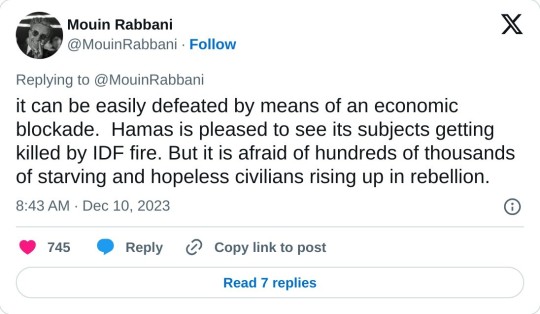
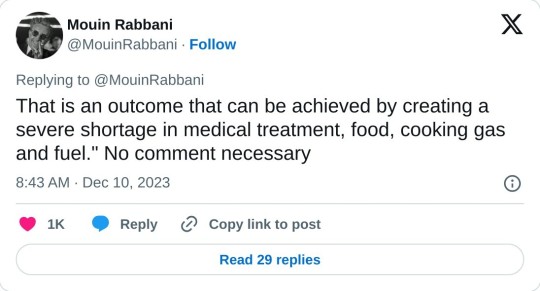
First, this shows a delusional lack of understanding of Hamas by a former Israeli general. Hamas is neither pleased to see its own people destroyed (all of its fighters are Gazans, born and raised there. The people being killed their relatives, friends and neighbours) nor is it worried about Gazans 'rising in rebellion.' Why would Gazans rebel against their own resistance movement instead of the IDF? I know some people are going to say, 'Eiland is trying to soothe a dissatisfied Israeli public,' but earlier today, the IDF released a statement about Yusuf al-Mansi who is being held and tortured.
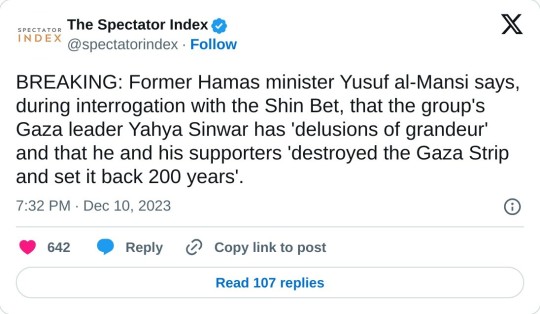
They're not just targeting Western audiences by trying to blame their crimes on Hamas, they're also trying to convince Gazans.
Look at all the dumb decisions made by the IDF - tanks with no infantry support, urban warfare against a guerilla army with an extensive tunnel system, letting their soldiers filming themselves (which both alienates the world and gives away their location), lying very incompetently about the war crimes it commits (like the siege and destruction of Al Shifa Hospital), releasing videos of IDF fighters shooting at walls, furniture, the air itself, etc and that's just in Gaza. The Israel government is now threatening to start war in Lebanon and fight the Ansar Allah group in Yemen the same time.
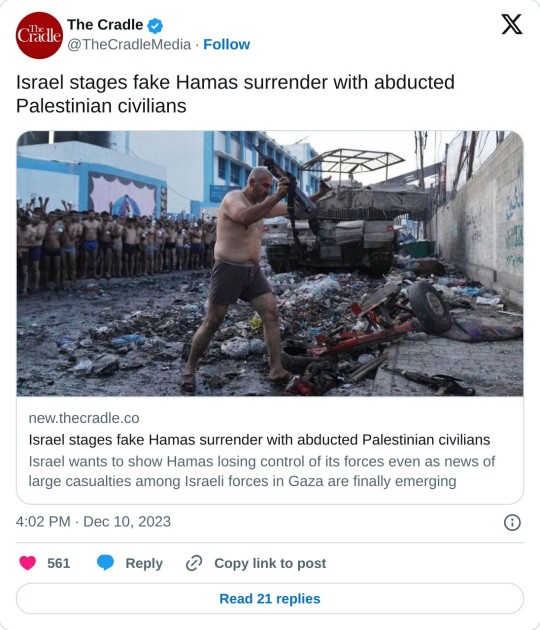
Secondly this signals that Israel has no intention of ending the siege soon. While Gazans are at risk of mass starvation, the real threat is disease, particularly illnesses like typhoid, cholera and dysentery.
We must not stop demanding that Gazans get sufficient humanitarian aid (not 20 measly trucks of expired food)
#yemen#jerusalem#tel aviv#current events#palestine#free palestine#gaza#free gaza#news on gaza#palestine news#news update#war news#war on gaza#war crimes#genocide#edited
2K notes
·
View notes
Note
Do you have an analysis on Sinwar being the new politburo chief? Very unexpected choice.
Have a couple thoughts:
Dissolving more of the barrier between Hamas as a political organization & as an insurgent organization
Spitting in Israel's face who was hoping that a decapitation strike would leave hamas with a leader lacking broader political legitimacy in the organization or create divisions/deepen divisions between civilian governance & militant organization
Lessens the leverage Qatar has over Hamas as they were providing Haniyeh with refuge
Since Sinwar is (presumably) in Gaza, his presence will likely be used to justify decreasingly discriminate attacks even moreso than it was before
Likely much more uncompromising (not to imply Haniyeh was) in negotiations
Israel and the US will have to directly negotiate with someone they despise
Dropsite News describes sinwar as such:
Despite the sinister portrayals, Sinwar’s writings and media interviews indicate he is a complex thinker with clearly defined political objectives who believes in armed struggle as a means to an end. He gives the impression of a well-educated political militant, not a cult leader on a mass suicide crusade. “It's not this black image of Sinwar as a man with two horns living in the tunnels,” said Hamad, the Hamas official who worked directly with Sinwar for three years. “But in the time of war, he's very strong. This man is very strong. If he wants to fight, he fights seriously.”
In 1988, just months after Hamas was founded, Sinwar was arrested by Israeli forces and sentenced to four life sentences on charges he had personally murdered alleged Palestinian collaborators. During his 22 years in an Israeli prison, he became fluent in Hebrew and studied the history of the Israeli state, its political culture, and its intelligence and military apparatus. He translated by hand the memoirs of several former heads of the Israeli intelligence agency Shin Bet. “When I entered [prison], it was 1988, the Cold War was still going on. And here [in Palestine], the Intifada. To spread the latest news, we printed fliers. I came out, and I found the internet,” Sinwar told an Italian journalist in 2018. “But to be honest, I never came out—I have only changed prisons. And despite it all, the old one was much better than this one. I had water, electricity. I had so many books. Gaza is much tougher.”[...]
Sinwar, unlike leaders of Al Qaeda or ISIS, has regularly invoked international law and UN resolutions, exhibiting a nuanced understanding of the history of negotiations with Israel mediated by the U.S. and other nations. “Let's be clear: having an armed resistance is our right, under international law. But we don't only have rockets. We have been using a variety of means of resistance,” he said in the 2018 interview. “We make the headlines only with blood. And not only here. No blood, no news. But the problem is not our resistance, it is their occupation. With no occupation, we wouldn't have rockets. We wouldn't have stones, Molotov cocktails, nothing. We would all have a normal life."
Throughout 2018 and 2019, Sinwar endorsed the large-scale nonviolent protests along the walls and fences of Gaza known as the Great March of Return. “We believe that if we have a way to potentially resolve the conflict without destruction, we’re O.K. with that,” Sinwar said at a rare news conference in 2018. “We would prefer to earn our rights by soft and peaceful means. But we understand that if we are not given those rights, we are entitled to earn them by resistance.”[...]
After the end of Israel’s 11-day bombing campaign against Gaza, Sinwar spoke to VICE News and sought to frame the Palestinian struggle in a U.S. context, using recent cases of lethal police violence against African Americans. “The same type of racism that killed George Floyd is being used by [Israel] against the Palestinians in Jerusalem, the Sheikh Jarrah neighborhood, and in the West Bank. And by the burning of our children. And against the Gaza Strip through siege, murder, and starvation.”
And additionally (echoing the words of Hagari)
Support among Palestinians for Hamas and its Gaza leader Yahya Sinwar, according to the recent poll, “remains very high” and has increased during the past three months. At the same time, while two-thirds of Palestinians polled in the occupied territories believe that Hamas will “win the war,” only 48 percent of those in Gaza agreed.
Hamas has insisted the war cannot destroy its movement and will remain part of the tapestry of Palestinian factions governing its besieged and occupied territories. “What matters is that you finally realize that Hamas is here. That it exists. That there is no future without Hamas, there is no possible deal whatsoever, because we are part and parcel of this society, even if we lose the next elections,” Sinwar warned in 2018. “But we are a piece of Palestine. More than that, we are a piece of the history of the entire Arab world, which includes Islamists as well as seculars, nationalists, leftists.”
Daniel Hagari has also echoed this last bit [TimesOfIsrael is Israeli Private Media]
“Hamas is an idea, Hamas is a party. It’s rooted in the hearts of the people — anyone who thinks we can eliminate Hamas is wrong,” he continued.
Rumors are that Netanyahu is trying to figure out necromancy in order to bring Haniyeh back
Also check out this interview conducted by Vice
youtube
761 notes
·
View notes